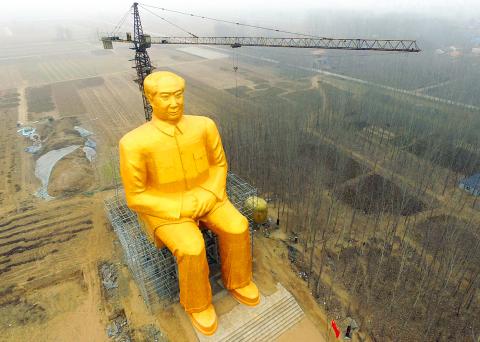Just two days after images of a giant gold-colored statue of Mao Zedong (毛澤東) in the bare fields of Henan province spread across the Internet, the statue was gone — torn down apparently on the orders of embarrassed local officials.
Villagers said demolition teams arrived Thursday morning, and by Friday morning, only a pile of rubble remained.
The 36m-tall statue, which local media reports said cost about NT$15.5 million, had been under construction for months and was nearing completion when it began to attract attention.

Photo : AFP/China Daily
Some commenters on social media denounced the extravagance of the colossus in a poor, rural part of China, where the money might have been better spent on education or health care. Several quoted from Ozymandias, Percy Shelley’s meditation on the ruins of a monument to a long-forgotten autocrat (“Two vast and trunkless legs of stone stand in the desert...”).
Others pointed out the historical irony of erecting the statue in one of the provinces worst hit by the famine caused by Mao’s Great Leap Forward.
It appears that the message was heard.
Public security officials and groups of unidentified men in olive-green greatcoats brusquely turned away visitors and blocked road access to the site of the statue, outside the village of Zhushigang.
Villagers said the guards had been sent by officials of Tongxu county, which includes Zhushigang. They said they believed that the statue was torn down on orders from provincial officials.
A person answering the telephone at the Tongxu county government offices said he did not know anything about the demolition. He referred a caller to the county propaganda department, where the telephone went unanswered. Another person, who answered the telephone at the local Sunying township, also said he had not heard of the demolition.
According to villagers and reports on online chat sites, the statue was the idea of a local businessman, Sun Qingxin (孫清新), the head of Lixing Group, a conglomerate that manufactures machinery and owns food-processing facilities, hospitals and schools. Sun paid for the statue, they said.
Sun is also the deputy chairman of the County People’s Congress Standing Committee, a powerful local position.
“He is crazy about Mao,” said a villager who identified himself as Wang, a potato farmer. “His factory is full of Maos.”
Two miles from the village, a guard outside Lixing Group’s headquarters shooed away reporters, refused interview requests and ordered that no photographs be taken, warning that “cars of people will arrive and make trouble” if a reporter lingered.
Facing the factory entrance, inside the premises, was a 3m golden statue of Mao, standing in a traditional Chinese pavilion of cream stone.
Statues of Mao, the founder of the People’s Republic of China, were once ubiquitous in China, and many survive. President Xi Jinping (習近平) has often praised Mao as a model for China today, saying Mao’s era was one when officials were selfless and honest.
But some of his policies were disastrous, including the forced agricultural collectivization and industrialization of the Great Leap Forward, which historians blame for a famine in which tens of millions of people died.
Still, a woman named Yang, 75, said several villagers cried when the statue was knocked down.
“Mao was our leader and ate bitterness for us,” she said.
On Friday, the site was shrouded in heavy fog, which was dense enough to close the nearby highway. A pile of debris and an orange crane were all that remained. Around the decay of that colossal wreck, boundless and bare, the brown and frosty fields stretched far away.

The canonical shot of an East Asian city is a night skyline studded with towering apartment and office buildings, bright with neon and plastic signage, a landscape of energy and modernity. Another classic image is the same city seen from above, in which identical apartment towers march across the city, spilling out over nearby geography, like stylized soldiers colonizing new territory in a board game. Densely populated dynamic conurbations of money, technological innovation and convenience, it is hard to see the cities of East Asia as what they truly are: necropolises. Why is this? The East Asian development model, with

June 16 to June 22 The following flyer appeared on the streets of Hsinchu on June 12, 1895: “Taipei has already fallen to the Japanese barbarians, who have brought great misery to our land and people. We heard that the Japanese occupiers will tax our gardens, our houses, our bodies, and even our chickens, dogs, cows and pigs. They wear their hair wild, carve their teeth, tattoo their foreheads, wear strange clothes and speak a strange language. How can we be ruled by such people?” Posted by civilian militia leader Wu Tang-hsing (吳湯興), it was a call to arms to retake

This is a deeply unsettling period in Taiwan. Uncertainties are everywhere while everyone waits for a small army of other shoes to drop on nearly every front. During challenging times, interesting political changes can happen, yet all three major political parties are beset with scandals, strife and self-inflicted wounds. As the ruling party, the Democratic Progressive Party (DPP) is held accountable for not only the challenges to the party, but also the nation. Taiwan is geopolitically and economically under threat. Domestically, the administration is under siege by the opposition-controlled legislature and growing discontent with what opponents characterize as arrogant, autocratic

When Lisa, 20, laces into her ultra-high heels for her shift at a strip club in Ukraine’s Kharkiv, she knows that aside from dancing, she will have to comfort traumatized soldiers. Since Russia’s 2022 invasion, exhausted troops are the main clientele of the Flash Dancers club in the center of the northeastern city, just 20 kilometers from Russian forces. For some customers, it provides an “escape” from the war, said Valerya Zavatska — a 25-year-old law graduate who runs the club with her mother, an ex-dancer. But many are not there just for the show. They “want to talk about what hurts,” she